April 2021 will see the 35th anniversary of the the world’s worst nuclear disaster – the explosion at the Chernobyl Nuclear Power Plant. In 35 days will be International Chernobyl Disaster Remembrance Day. To honor this commemorative event, until the anniversary of the accident, which happened on April 26th in 1986, we prepared 35 facts about Chernobyl Exclusion Zone Today.
#1 CHERNOBYL RECOVERY
Chernobyl has become a byword for catastrophe. No one doubts that the immediate ecological effects of the Chernobyl disaster were devastating. But Chernobyl’s Exclusion Zone isn’t a radioactive desert. More than three decades ago the world looked on in horror when the Unit 4 reactor at the Chernobyl NPP caught fire. HBO’s recent dramatisation Chernobyl showed the horrors of the accident itself, but what are the radiation risks to people visiting the area?
Radiation is scary, conjuring up images of atomic bombs, mutation and cancer, but we don’t forget that we are all continuously exposed to natural radioactivity from soil, rocks and space. Chernobyl tourists will receive a dose of radiation during 1 day tour not exceed 3-4 microsieverts (3-4% of nuclear power plant safety norms in EU), which is equivalent to around 4 hours on an intercontinental flight.
Nowadays, the vast majority of the Chernobyl Exclusion Zone wildlife is flourishing, not because radiation is good for the ecosystem, but because of the virtual absence of human activities for 35 years.
In the Chernobyl Zone, more than 400 species of vertebrates have been recorded:
- brown bears
- European bison
- Przewalski’s horses
- wolves
- deer
- elks
- lynxes
How long until Chernobyl will be completely safe?

Well, it depends on which part of Chernobyl you’re talking about. There are a lot of scientific publications where you can find such numbers as 300 years, 800 years, but the highly publicized number is 20,000 years – that refers specifically to the Elephant’s Foot, the highly radioactive remains of the reactor itself.
In a broader sense, it’s harder to say for sure how long it will be until Chernobyl is completely safe. Experts estimate anywhere from 20 years to several hundred years, because the contamination levels are not consistent in the surrounding area.
Despite misleading headlines, Chernobyl is recovering. Back in 2006, the World Health Organization identified that the social and psychological impacts of Chernobyl on people have been greater than the health effects from radiation.
#2 CHERNOBYL COSTED $700 BILLION
Huge efforts have been ongoing to maintain and keep safe the Chernobyl area in Ukraine since the infamous nuclear disaster that took place on 26 April 1986. Over the next 35 years, Chernobyl’s cost grew to $700 billion.
Why so much? Here are the primary reasons:
- The damage directly caused by the accident;
- The cost of sealing off the reactor;
- The creation of an Exclusion Zone of 30 kilometers around the Power Plant;
- The relocation of 137,000 people;
- Loss of power from the Chernobyl plant itself. Unit 4 was shut down. Reactors 1, 2, and 3 were restarted in October 1986. They produced power until December 2000.
- Health care for many of the 10 million people exposed to radiation;
- Seven million people are still receiving benefits payments in Russia, Ukraine, and Belarus;
- Toxic waste clean-up and disposal of radioactive waste;
- The monitoring of environmental radiation levels;
- Removing radioactive material from farmland and forests;
- Research to find out how to make contaminated food safe
In 1986 was constructed a concrete and steel Sarcophagus around Unit 4. This structure had weakened, so a permanent structure was built around it. It cost at least $765 million. The Safe Confinement structure was completed in 2019.
New Safe Confinement or New Shelter, this 32,000-ton structure—which took around a decade to build at a cost of $2.1 billion.
The Chernobyl accident cost more than Hurricane Katrina, estimated at between $125 billion and $250 billion
#3 СRASHED HELICOPTER WAS FOUND
In 2017, during the dismantling of the flooring of the post-accident light roof of the engine room of Unit №4 of the Chernobyl Nuclear Power Plant, was found a part of the tail with broken elements of the steering propeller of the Mi-8 helicopter, which crashed in 1986 during the Chernobyl disaster response.
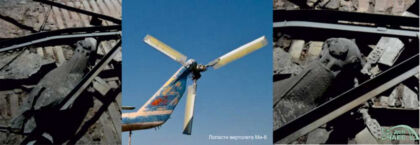
Source: Chernobyl NPP
According to the Chernobyl SSE, on the evening of October 2, 1986, during the spilling of bonding adhesive over ChNPP Unit 4, Vladimir Vorobyov’s helicopter caught the cable with its blades due to the absence of a high-altitude crane on the cable and fell to the ground. All crew members died as a result of the fall.

A monument to the fallen pilots has been erected near the helipad in the city of Chernobyl. The possibility to retrieve and decontaminate the tail fins piece to use it as a museum specimen is under consideration.
#4 THE MOST RADIOACTIVE PLACES IN THE CHERNOBYL EXCLUSION ZONE
Chernobyl & radiation, two words, which have been linked for decades. Today you do not have to worry about visiting Chernobyl because the places, which are visited by tourists are decontaminated and cleaned.
But there are several places, which are still dangerously radioactive and visiting them is not recommended, completely prohibited or allowed with protective cloths and radiation specialist (room 4):
- Pripyat hospital No. 126 – 2-3 roentgens per/h
- Red Forest – Radioactive hotspots vary inside the Red Forest, and have been measured anywhere between 0.1-10 mSv/h
- Radioactive Graphite Claw – 300 – 1000 mSv/h
- Basement of Jupiter plant in Pripyat over 2500 mSv/h
- Room #4 at the Chernobyl Nuclear Power Plant between 10 – 35 mSv/h
The normal level of natural radiation exposure is up to 0.3 μSv/hour.
Pripyat hospital No. 126

Radioctive firefighter’s clothes in Pripyat hospital basement.
Source: Reddit
Everyone has already heard about the basement of the Pripyat hospital No. 126. This is the place, where all the clothes and accessories of the firefighters and employees, which were fighting with the fire at the Chernobyl Nuclear Power Plant, are laying. Pripyat hospital was nursing these people right after the disaster back in 1986. The firefighters and other liquidators got so much radiation, that they died within a year from radiation sickness. Their clothes are, however, still there, buried and emitting dangerous doses of radiation 500 μSv/h (in some places over 1000 μSv/h)!
Red Forest

Red Forest. Summer 1986.
Photo: Unknown
A patch of mostly pine trees west of the Chernobyl Power Plant was hit by immense radiation, turned a rustic bright red and died. The Red Forest expanse remains one of the most contaminated areas in the world today, in fact, it’s known as one of the most radioactive outdoor environments on the planet.
Most recently in April of 2019, a team of experts led by the National Centre for Nuclear Robotics (NCNR) spent two weeks surveying the Red Forest and its surroundings. They informed, tha radioactive hotspots vary inside the Red Forest, and have been measured anywhere between 0.1-10.0 mSv/hour.
Jupiter factory
It was opened in 1980 on the south-west outskirts of Pripyat and employed nearly 3500 people at its peak. Jupiter factory remained open for a few years after the accident until the early 1990’s (as proof, you still can find there calendars and dated documents)

Jupiter Factory basement.
Source: Reddit
The official production of tape recorders was a smokescreen for the real purpose – electronics and semiconductors for the military industry. Some sources go as far as claiming that not a single tape recorder has ever left Jupiter factory and was nothing but a cover-up for a strictly military operation.
The legends are surely fuelled by the boxes with a mysterious, highly radioactive grey powder and an underground laboratory full of chemicals in the basements. This discovery sparked an idea of Jupiter factory being a top-secret nuclear weapons factory.
#5 LENIN EVERYWHERE
The Lenin cult pervaded the public life of the Soviet Union. Today its paraphernalia — plaques, posters and books — are part of the Soviet Union’s ‘remains’. The Lenin cult was an organic part of the Soviet political system; each leader presented himself as a true Leninist.

A two-meters high bust of Lenin stood at the Chernobyl Nuclear Power Plant. Now stored in the room used by the cleaning lady.
Source: magazine.nv.ua
Decommunization in Ukraine started after the collapse of the Soviet Union. But only in 2015 it was formalized,when the Ukrainian government approved laws that outlawed communist symbols.
The head of the Ukrainian Institute of National Remembrance Volodymyr Vyatrovich said that the authorities would not decommunize the Chernobyl Exclusion Zone. That’s why it seems that radiation has frozen the Soviet Union with its symbols and slogans – monuments to Lenin.

Postcard with Lenin face, found in one of Pripyat buildings.
Photo: CHERNOBYLwel.come
Today the Exclusion Zone is the most terrible, but at the same time extremely expressive monument to the communist totalitarian regime:
- Abandoned avenues and streets of Chernobyl and Pripyat, with the once loud names – Proletarskaya st., Lenin st., Chekistov, Sovetskaya, Red Banner st., Sverdlova…
- The ‘Chernobyl Nuclear Power Plant’ was officially named the ‘Vladimir Ilyich Lenin Nuclear Power Plant’.
- Postcards, books and posters with Lenin;
- Lenin statue in Chernobyl town;
- Bust of Lenin
- “Glory to Lenin” on the roof of the “White House” in Pripyat.
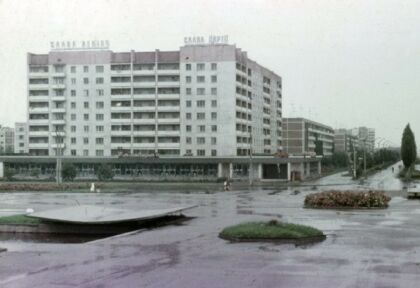
“Glory to Lenin” on the roof of the “White House” in Pripyat.
Source: pripyat-city.ru
These exhibits of the communist system you will find in different parts of the Chernobyl Exclusion Zone.
#6 CONTROL ROOM 4 IS OPEN FOR VISITS
For decades, the tourists who did come to the Chernobyl Exclusion Zone were only permitted to observe abandoned villages, city Pripyat, Chernobyl town, Duga Radar and Chernobyl NPP outside. Those areas aren’t considered dangerous anymore; in fact, you’d probably receive a higher dose of radiation from the flight over.

But the infamous Reactor 4, where the explosion occurred, remained closed to everyone except researchers, cleanup workers, and a few journalists — until now.
Closed for over 30 years, NOW SAFE AND OPEN for you to peek into the most epic part of the Chernobyl story. A place where time stopped the very moment of April 26 when reactor 4 (just 30 meters away) exploded and changed the history of mankind and the destiny of millions of people.
From 2020 everyone has the unique chance to dive to the very place where Anatoly Dyatlov commanded his colleagues, and where the AZ-5 (SCRAM) button was pushed too late. It is the most radioactive place you can legally visit in the Chernobyl Zone with the absolute assurance it is safe.
The control room 4 sits under the new containment arch but outside of the original sarcophagus that contained the radiation of the reactor itself. According to Ruptly, a German news agency, the radiation in the room is 40,000 times higher than normal levels.
Visitors have to wear protective suits, helmets and masks and are limited to 5 minutes inside the room. Afterward, they will undergo 2 mandatory radiology tests to gauge their exposure.
#7 THE WORMWOOD STAR PROPHECY
The “Star Wormwood” memorial complex was built in 2010 – 2011, to the twenty-fifth anniversary of the Chernobyl accident, located in the historic center of Chernobyl town. The idea to create a memorial complex arose in the 90s.

Monument of the Third Angel in Chernobyl town.
Photo: CHERNOBYLwel.come
The sculpture, created by Ukranian artist Anatoly Haidamaka, who is also known for his artistic design of the National Chernobyl Museum in Kiev.
“Monument of the Third Angel” not only honors the people who risked it all to combat the Chernobyl catastrophe, it also adds a biblical edge to the events. Its name was inspired by a passage from the New Testament, Revelation 8:10-11:
“And the third angel sounded, and there fell a great star from Heaven, burning as it were a lamp, and it fell upon the third part of the rivers, and upon the fountains of waters; And the name of the star is called Wormwood: and the third part of the waters became wormwood; and many men died of the waters, because they were made bitter.”
In the book of revelations, an angel predicted a giant star, a “wormwood” star would bring on doomsday. You might ask, what does Chernobyl have to do with it?

The stone with the words from the New Testament, Revelation 8:10-11 in Ukrainian, Chernobyl town.
Photo: CHERNOBYLwel.come
The name “Chernobyl” is the same as one of the Ukrainian names for “Artemisia vulgaris”, “mugwort” or common “wormwood”. Because of the reference to wormwood, people began speculating that the Bible predicted the disaster.
#8 BOSTON DYNAMICS ROBOT AT CHNPP

Boston dynamics robot at the Chernobyl Nuclear Power Plant under the New Safe Confinement.
Source: chnpp.gov.ua
On October 22, 2020, engineers of the University of Bristol visited the Chernobyl Nuclear Power Plant. The purpose of the visit was to test the remotely controlled robots under the Chernobyl Exclusion Zone conditions, and one of such robots was a world-famous Spot, a robot-dog, developed by the Boston Dynamics.
Robot Spot has such unique features:
- it can move in complex terrain such as stones or debris;
- walk up sloping surfaces and stairs;
- get over obstacles.
On its “back”, it has a special platform for installing the equipment to use the robot for remote radiation survey.
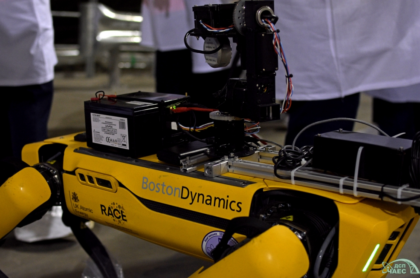
“We came to the Chernobyl Exclusion Zone to use the robotic platforms for mapping the distribution of radiation, test our robotic platforms and build new networks of people. To work here within the NPP is an exciting opportunity for us. And we have an ability to demonstrate to your personnel what we can do and how we might be of help. Hopefully, everything we have seen here will make us better understand your problems”, says David Megson-Smith, a Senior Postdoctoral Researcher in the University of Bristol.
The University of Bristol has worked a lot with the nuclear organizations in the UK, but the Chernobyl NPP environment is a new area for them. The University is interested in further cooperation and it plans future visits to the Chernobyl NPP in 2021 for testing other dosimetry technologies and presenting to the ChNPP the technologies that may be used during the radioactive waste management and dismantling activities.
#9 CHERNOBYL WILD HORSES
After a nuclear disaster that happened 35 years ago, the Chernobyl Exclusion Zone became one of the wildest places in Europe. The area is occupied by diverse -including rare and endangered- species, making the place unique.
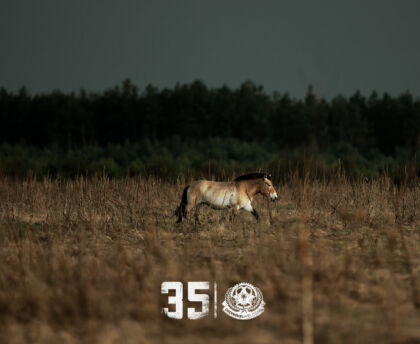
At the time of the accident at the Chernobyl Nuclear Power Plant there were no Przewalski horses in Chernobyl. It was not until 1998 when the first 31 arrived in the Exclusion Zone. They were 10 males and 18 females from the Askania Nova nature reserve in southern Ukraine, and three males from a local zoo.
After high mortality associated with the process of transfer and release, the high birth rate brought the population to 65 in just 5 years. The intense poaching between 2004 and 2006 decimated the population. Only 50 survived in 2007.
Intense protection measures have allowed that just 20 years after their arrival in Chernobyl Zone their number has multiplied by 5.
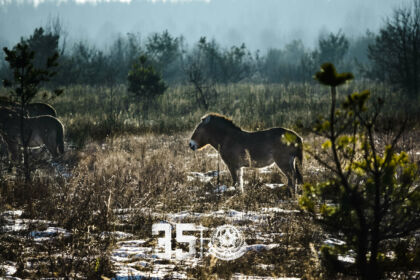
In 2018, local scientists revealed that about 150 individuals live in the Ukrainian part of the Exclusion Zone. Horses are grouped into 13 harem herds with foals, 6 stallion groups, and some solitary individuals. In 2018 at least 22 foals were born in the Exclusion Zone. Some have moved further north and have already settled in Belarus.
The case of Przewalski’s horses shows that it’s not a cemetery, not a radioactive desert – this is the place where life is in full swing. In the absence of humans, the large Chernobyl area has become a refuge for wildlife.
#10 CHERNOBYL IN FILMS AND DOCUMENTARIES

This year is the 35th anniversary of the Chernobyl disaster, the accident that shook the world, changed and derailed thousands of lives, leaving deep, lasting scars. Nowadays, except Chernobyl HBO miniseries, there are a number of films that have endeavored to explain and examine what happened on April 26, 1986 — and what continues to happen in the aftermath:
- The Battle of Chernobyl (2006) – discovery documentary, directed by Thomas Johnson, 2006
The film follows the Soviet Union’s attempt to cover up and downplay the disaster and the containment efforts preventing another explosion that threatened to destroy half of Europe. - Chernobyl.3828 – documentary, directed by Valeriy Starodumov, 2011
The 30-minute Ukrainian documentary film consists largely of on-site footage and tells the story of the months-long containment effort following the meltdown. - Chernobyl Heart – documentary, directed by Maryann DeLeo, 2003
The stories of children and families grappling with life-threatening and fatal health problems are a reminder that Chernobyl isn’t a thing of the past. - Decay – drama, directed by Mykhailo Belikov, 1990
A Russian epic, a science-fiction docudrama that offers the 1986 Chernobyl disaster as a metaphor for the moral decay in the then-Soviet Union.
- The Russian Woodpecker (2015)
Winner of the Sundance Grand Jury Prize, The Russian Woodpecker approaches Chernobyl from a slightly different vantage point: through the eyes of artist Fedor Alexandrovich. Personally affected by the radiation, Alexandrovich believes that the Chernobyl disaster wasn’t simply an accident.
The Russian Woodpecker has been lauded for its wildly inventive narrative and the way in which it frames what might be an easily dismissed conspiracy theory as a very real, plausible and troubling possibility. It poses a vital, uncomfortable question: “What if Chernobyl was a crime?”
- Chernobyl Diaries – mystery/Thriller, directed by Brad Parker, 2012
The film follows a group of six young vacationers who, looking to go off the beaten path, hire an extreme tour guide, who takes them into the city of Pripyat. - Inseparable – miniseries, directed by Vitaliy Vorobyov, 2013
This is an account of love and loss, bravery and supernatural stoicism in the face of unbeatable odds. The story about love and death in the epicenter of the explosion.
#11 CONSTRUCTION OF THE NEW SAFE CONFINEMENT
The old Sarcophagus was constructed in extremely complicated radiation conditions during a very short time. It does not comply with the rules and norms for designing, construction, commissioning and operation of not only nuclear facilities or facilities for radioactive waste management, but also for civil industrial facilities.
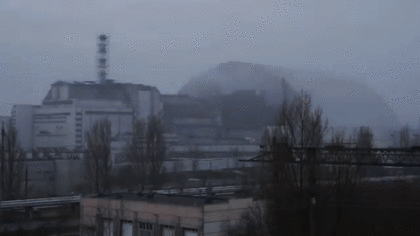
That’s why it’s incapable to fully solve the safety problem of the damaged power unit No 4 due to leak tightness problems arising since time and degradation of civil structures of the old Sarcophagus. This situation called for the construction of a new protective structure over.
The project is carried out in three stages:
- Preparatory work, providing a safe and efficient NSC construction.
- NSC designing, manufacturing, construction and commissioning. The whole complex of necessary tests and commissioning.
- Early dismantling of old Sarcophagus structures.
NSC timeline:
- March 2004 – announcing an international tender for New Safe Confinement design and construction.
- August 10, 2007 – a contract for the New Safe Confinement construction was signed between SSE „Chernobyl NPP“ and international consortium NOVARKA.
- 2009 – stabilization of the existing Sarcophagus, which was then considered stable enough for another 15 years.
- September 2010 – Novarka began construction.
- November 26, 2012 – the first sections were raised.
- April 2016 – construction of the arches was completed.
- April 2019 – successful conclusion of the 72-hour trial operation test.
- July 2019 – construction on the €1.5 billion structure is completed and the sarcophagus is opened to media visits on 3 July.
#12 KYIV CHERNOBYL MUSEUM
The Chernobyl disaster in 1986 was a catastrophic event, which awakened the world to the potential dangers of nuclear energy and revealed the disastrous effects of a nuclear incident. After this catastrophe appeared the need to understand the Chernobyl accident and its magnitude. That’s why on April 26, 1992 the Chernobyl Museum opened in Kyiv.

The National Museum “Chernobyl” in Kyiv.
The National Museum “Chernobyl” in Kyiv is a multifunctional institution combining scientific, cultural and educational activity with a modern museum and archive, documenting,preserving and conveying the history of the Chernobyl nuclear disaster as the most severe radioecological disaster of the XX century.
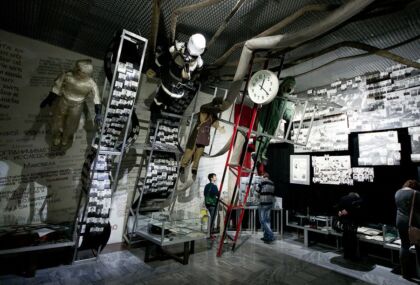
It houses an extensive collection of visual media, artifacts, scale models, and other representational items designed to educate the public about many aspects of the disaster. Several exhibits depict the technical progression of the accident, and there are also many areas dedicated to the loss of life and cultural ramifications of the disaster.
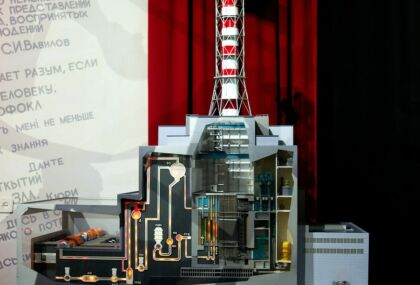
Model of the Chernobyl Nuclear Power Plant, the National Museum “Chernobyl” in Kyiv.
Entering the museum you will be greeted by slogan “Est dolendi modus, non est timendi”. Translated from Latin it means “There is a limit of sadness, anxiety has no limits”.
There are also audio guides translated not only in English, but in many others. So if you are going to visit the Chernobyl Exclusion Zone, we advise you to set aside time for the Chernobyl Museum in Kyiv. Another one museum you can visit in the town of Chernobyl.
#13 STALKERS

Another interesting fact about nowadays Chernobyl is Stalker.
Stalker is someone who defies the official government prohibitions and secretly enters the Zone in the spirit of exploration, romance, bravado, desperation or simply because they found a way to get in undetected. For them it’s “post-apocalyptic romantics”, where Pripyat has become the Holy Grail.
Existing in the shadows of this highly commodified industry is the secretive subculture of the “stalkers”: mostly young Ukrainian men who sneak into the Zone illegally to explore the vast wilderness on their own terms.
The term “stalkers” has come to be used for those who sneak into the Zone. It’s a word and a cultural type with deep resonance in this part of the world, first appearing in a 1971 science fiction novel called Roadside Picnic, by the Russian brothers Arkady and Boris Strugatsky.

It tells the story of contaminated “zones” created on Earth by aliens, in which rogue stalkers roam, hoping to recover valuable alien technology. The book inspired Andrei Tarkovsky’s 1979 cult-classic film Stalker.
Roadside Picnic and Stalker were created 15 and seven years, respectively, before the Chernobyl accident spread radiation throughout the region, also proved prescient.
In 2007 the stalker legend was updated for the digital age when a team of young Ukrainian designers released a post-apocalyptic first-person shooter video game they called S.T.A.L.K.E.R. set in the Exclusion Zone around Chernobyl.
#14 NEW SAFE CONFINEMENT FAST FACTS
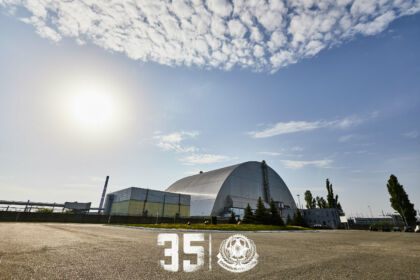
The New Safe Confinement is a megaproject that is part of the Shelter Implementation Plan and supported by the Chernobyl Shelter Fund. It was designed with the primary goal of confining the radioactive remains of reactor 4.
The total cost of the Shelter Implementation Plan, of which the New Safe Confinement is the most prominent element, is estimated to be around €2.15 billion (US$2.3 billion). The New Safe Confinement cost €1.5 billion and was financed by 45 donor countries and institutions
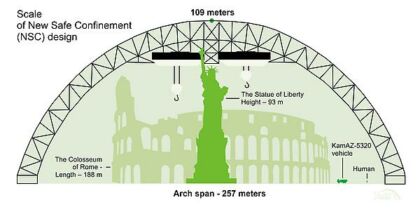
Source: chnpp.gov.ua
Specification:
- Width – 257 m
- Height – 109 m
- Length – 188 m
- Weight approx. – 36,000 tonnes
- Life time – 100 years
- Construction started in September 2010 and completed in July 2019 made of more than 80 elements held together with 600,000 bolts
- The French consortium Novarka designed and built the New Safe Confinement.
Argentina, Australia, Austria, Azerbaijan, Belgium, Canada, China, Croatia, Czech Republic, Denmark, Estonia, European Union, Finland, France, Germany, Greece, Hungary, Iceland, India, Ireland, Israel, Italy, Japan, Kazakhstan, South Korea, Kuwait, Liechtenstein, Lithuania, Luxembourg, Netherlands, Norway, Poland, Portugal, Romania, Russia, Saudi Arabia, Slovak Republic, Slovenia, Spain, Sweden, Switzerland, Turkey, Ukraine, United Kingdom, USA, EBRD.
The project was handed over to the Ukrainian authorities in July of 2019. The confinement is now in place, and specialized, remote-operated equipment is commissioned and ready for the day when the reactor building can be demolished. That could be 100 years from now, after radioactivity has decayed to acceptable levels.
#15 DECLASSIFIED KGB ARCHIVES ABOUT CHERNOBYL

In 2020, the Archive of the Security Service of Ukraine (SSU) and the Ukrainian Institute of National Remembrance (UINR) opened archives about the accident at the Chernobyl Nuclear Power Plant. In June same year, the SSU press-service reports with reference to a second book of the collection “KGB Chernobyl Dossier. From construction to the accident. ”In particular, it is noted that accidents at the Chernobyl Nuclear Power Plant occurred before April 1986, but no one was informed about them.
In total, the book contains 229 documents, 190 of which have been published for the first time.

Photo: Security Service of Ukraine
„There are reports of accidents that occurred in 1986, a transcript of telephone conversations at the Chernobyl Nuclear Power Plant on the night of April 26, a copy of the first accident report, information about the beginning of the investigation and the construction of the“ Sarcophagus „(above the emergency station block),“ says the archive director of the SSU and one of the compilers of the book Andrii Kohut.
The publication mentions the prerequisites of the disaster, the report, and materials that indicate the small accidents that occurred in Chernobyl earlier, but had been hidden.
In the documents it is noticed that from 1971 to 1981 at the ChNPP there were 29 emergency stops. Eight of them had been the fault of the staff. In addition, the SSU published documents about the consequences of a liquidation in 1986, and on the unpreparedness of state bodies for a tragedy of this magnitude. It indicates the lack of necessary work clothing and equipment for rescuers, and the fact that the radiation situation had not been well understood. According to the declassified materials of the KGB of the Ukrainian SSR, even after the tragedy of April 26, 1986, nobody controlled the control panels of the NPP for some time.
#16 CHERNOBYL FIRES

Wildfires are not a new phenomenon to the Chernobyl Zone ecosystem. Some last several days, others almost a week, but none of them were as terrible and dangerous as the ones we experienced in 2020.
April 4 – the day when the largest wildfire in the history of the Chernobyl Exclusion Zone began. Chernobyl wildfires were from 4th of April and lasted till 15 of April 2020, destroying everything in its path.
The 13th of April was the most stressful day, because fire reached the territories of the ChNPP. Thanks to firefighters and fire protection, Chernobyl NPP wasn’t damaged.

Hundreds of firefighters, supported by aircraft, battled the fires for two weeks. Only in the end of April Ukrainian emergency officials were able to announce that any incidents had been prevented.
During the whole April, emergency services kept measuring radiation levels and confirmed that radiation rates at Kyiv, the country’s capital located about 130 km south of the plant, remained within norms.
It was concluded that fires were most probably caused by residents burning waste, as the fires quickly turned into blazes.
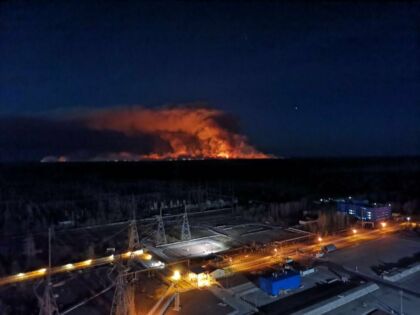
View from the Chernobyl Nuclear Power Plant on April 11, 2020.
Unfortunately, during these days of a desperate fight with fire in the Chernobyl Exclusion Zone, we completely or partially lost these unique former settlements and places:
- Polisske
- the former Volkhov missile base
- the „Skazochny“ pioneer camp
- the Emerald recreation center (completely destroyed)
- villages Kopachi and Leliv
- partly the town of Chernobyl -2
- the railway station Yaniv, the village of Lesnyi, Rossokha, Grezlya Rudnya-Grezlyanska, Kovshilovka
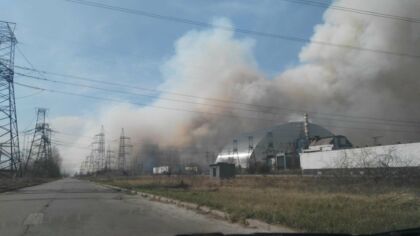
The 12th of April fire came close to the Chernobyl Nuclear Power Plant.
The April 2020 Chernobyl wildfire was currently the largest we’ve experienced to date:
- 1066 people participated
- 253 units of equipment including 2 helicopters
- 60 000 hectares burned down to ashes
- Increasing of the radiation on the Red Forest territories
- Endangering of animal being
- A lot of localities are burned down – 25 locations
#17 DAVID ATTENBOROUGH IN CHERNOBYL
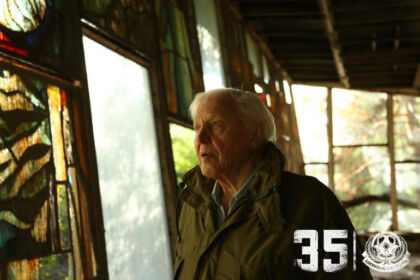
Sir David Attenborough pictured in Pripyat (Chernobyl Exclusion Zone) while filming A Life on Our Planet.
In 2020, on Netflix was released Sir David Attenborough’s latest show – “A Life On Our Planet”.
The documentary opens with its title plot set in a desolate place. This is the Chernobyl Exclusion Zone – a place so utterly destroyed and scarred by humans. The City of Pripyat, once a noisy area that was evacuated after human error made it uninhabitable.
At the end of September 2018, David spent about a week filming in Chernobyl Zone. Despite his age, he worked on the site like everyone else, and joked about his condition when someone obsessively wanted to help him.

Footage from the documentary “A Life on our Planet”in Pripyat, David Attenborough.
The first frame shows an abandoned house in the city of Pripyat, and on the roof of which you can see the well-known symbol of the Soviet Union „Hammer and Sickle“.
David Attenborough is standing in a deserted building with broken walls and shattered glass on the floor. The abandoned, dilapidated buildings of the ghost town accurately convey the atmosphere of the post-apocalypse. He carefully examines the remains of the past life. Emptiness and pain are what can be seen in his eyes.
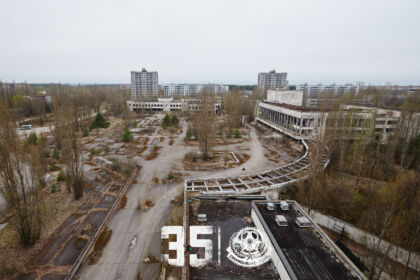
Pripyat city center today.
“Pripyat in the Ukraine is a place unlike anywhere else I have been. It is a place of utter despair. On the face of it, it seems quite a pleasant town, with avenues, hotels, a square, a hospital, parks with fairground rides, a central post office, a railway station. Almost everything is motionless – paused. If something is stirred by a gust of wind, it startles me”, says sir David.
#18 NEW MURAL ON CHERNOBYL NPP
In 2019, Przewalski’s horses decorated the wall of the Chernobyl Nuclear Power Plant. The author of the painting is the artist Valery Korshunov, the head of the national cultural project “Artefact art-project” on rethinking the Chernobyl disaster.

The canvas is of 18 m height and 58 m length, and it is located on the eastern wall of the Turbine Hall facing the ChNPP office premises.
Now it is the first and only picture on the building of the NPP. In addition to the aesthetic idea, it carries a much deeper – cultural and educational, says the author.
Przewalski’s horses are depicted on the wall not by chance. They inhabited the Exclusion Zone after the accident. Next to the animals is a giant hand that controls the atom. According to the creator, the picture symbolizes a rapid revival and hope for a better future.
“We must be strong, we must fill Chernobyl with new meanings every day, bring here, firstly, culture, and secondly, technology, and return Chernobyl to normal life,„says Valery.
#19 DESIGN CONCEPTS OF SHELTER OBJECT

Photo: NOVARKA
The creation of a New Safe Confinement (NSC) is the main stage of preparation for the transformation of the Shelter into an environmentally safe system.
It should be noted that already soon after the construction of the Shelter (old Sarcophagus), given the low reliability and durability of its building structures, experts proposed various options for creating additional protective engineering barriers, in particular in the form of a new structure – the so-called Shelter-2.
But the most systematic and detailed work on this idea began in 1998.
The International Consortium ‘Chernobyl’ formed by the Washington Group International, Inc (USA), BNFL Engineering Ltd (UK) and Ukrainian organizations: Kyiv Institute ‘EnergoProekt’(KIEP), Research Institute of Engineering Structures (RIES) and Institute for Safety Problems of NPPs (ISP NPP) performed comprehensive analysis of all the earlier technical decisions, stated NSC conceptual design criteria and requirements, and proposed the strategy of its construction.
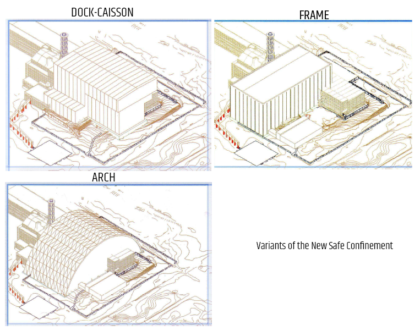
The following three confinement options(swipe right to see the cocepts):
- DOCK-CAISSON
- FRAME
- ARCH
These three confinement options had approximately the same indicators. Further evaluation of the above mentioned options with independent Ukrainian experts representing the International Advisory Group involved resulted in the ‘ARCH’ option selected.
During 2004–2007 the Tender exercise for the NSC construction took place, the Consortium NOVARKA was selected as a preferred bidder that provided its Technical Tender based on the NSC CD adaptation.
In September 2007 the contract was signed between the SSE ChNPP (Employer) and NOVARKA (Contractor) for design, construction and commissioning of the NSC Commissioning Stage (NSC CS-1).
#20 RED FOREST TODAY

Red Forest. Summer 1986.
After midnight on the 26th of April, 1986, a steam explosion and ensuing fire at the Chernobyl Nuclear Power Plant led to the single greatest uncontrolled environmental release of radioactivity.
Just 500 m away from the NPP, a 400-hectare section of pine forest received the most significant fallout dosage with radiation so intense that many of the trees died instantly, turning a rustic bright orange. The staggering variation in color earned the now world-renown name: The Red Forest.
The Red Forest expanse remains one of the most contaminated areas in the world today, in fact, it’s known as one of the most radioactive outdoor environments on the planet.
Back to 1986, considering the nature of the radiation effects, scientists have classified four zones:
- The 1st Zone – Zone of complete destruction of conifers with partial damage to deciduous trees (the so-called „Red Forest“). The area of this zone is about 4.5 thousand hectares. The levels of absorbed dose (according to scientists‘ calculations) by external gamma irradiation in 1986-1987 amounted to 80-100 Sv.
- The 2nd Zone – Zone of sublethal forest damage, in which 25 to 40% of trees died. The levels of absorbed dose – 10-80 Sv. The area – 12.5 thousand hectares.
- The 3rd Zone – Zone of moderate damage to the pine forest. Absorbed dose – 4-5 Sv.
- The 4th Zone – an area of mild damage, where there were some anomalies in the growth processes. No visible damage was found on the pines. All trees retained the normal growth and color of the needles. The absorbed dose – 0.5 – 1.2 Sv.
In 2019, the UK’s National Centre for Nuclear Robotics (NCNR) has developed a drone-mapping system that allows scientists to investigate hazardous places from a safe distance.
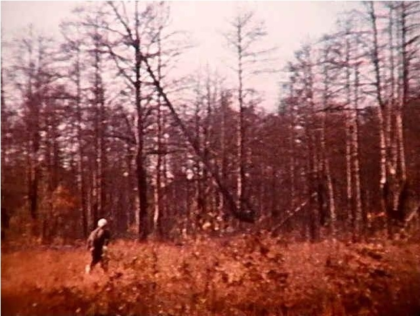
Red Forest from footage from 1986.
Their discoveries found hotspots of radioactive material that doesn’t appear on official maps with radiation levels about 1.2 millisieverts an hour. As a comparison, the average person experiences 2.4 millisieverts per year of background radiation. That would mean that in these places you’d be able to hit your yearly dose within just a few hours.
Today the Red Forest is being restored – young spruces and pines grow here, but it is still prohibited to visit Red Forest (the exception are scientists), because 90% of radioactivity in the Red Forest still remains in the soil itself.
#21 THE FIRST SOLAR POWER PLANT IN CHERNOBYL
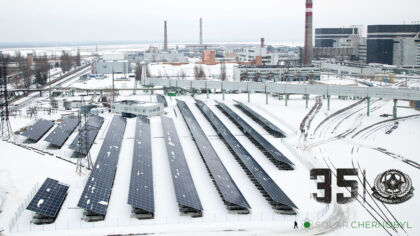
Photo: Solar Chernobyl
The Chernobyl NPP is the first where the alternative energy is being generated. The installation of this solar plant marked the first time the area has produced power since 2000, when reactors No. 1, 2, and 3 of the nuclear plant were finally closed.
The Solar Chernobyl is a project of implementing renewable energy projects within the areas affected by the Chernobyl disaster. Construction of solar parks within the contaminated areas enables Ukraine to use these lands in economic activity.
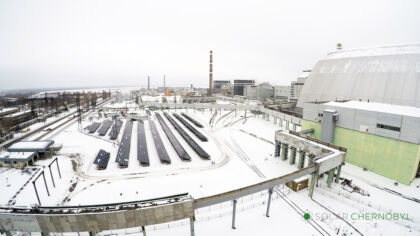
Photo: Solar Chernobyl
History of the project:
- 2013 – the idea of the Project
- 2015 – beginning of cooperation with Chernobyl NPP
- 2016 – preparation of the Investment Object
- 2017 – construction of Solar Power Plant
- 2018 – Completion and Commissioning of
- SPP SOLAR CHERNOBYL
Construction works of the first 1.0 MWp SPP were started in October 2017. 3,762 solar modules with a physical protection system were installed, transforming sub-stations were built and equipped.In 2018 was the official opening ceremony of the SOLAR CHERNOBYL Solar Power Plant.

Photo: Solar Chernobyl
The one megawatt solar plant cost approximately $1.2m and it is a collaboration between Ukrainian company Rodina and Germany’s Enerparc AG.
Solar Chernobyl is a project of successful long-term co-operation of the Ukrainian and German companies as the project initiators, organizers and executors.
#22 GAMES ABOUT CHERNOBYL

Game: Chernobyl Liquidators Simulator
Source: Steam
Chernobyl disaster is considered one of the biggest nuclear plant disasters in history up to date, so it’s not surprising that it gave life to many works of art, including video games. We collected games which are based or located in the Chernobyl Exclusion Zone.
S.T.A.L.K.E.R. Trilogy (2007-2009)
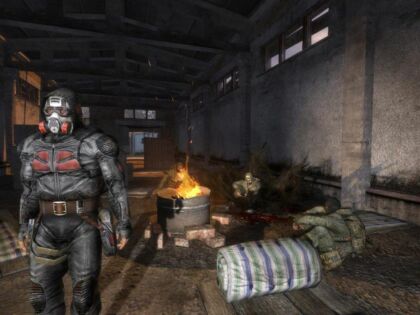
Game: S.T.A.L.K.E.R. Shadow of Chernobyl
Source: Steam
The game mixes a first-person shooter with survival horror and it does it well. It will bring you to the alternate reality, where not one, but two nuclear disasters occurred – the second one caused some strange anomalies inside the Chernobyl Exclusion Zone, and now you, as the Marked One, will need to find the answers, on top of trying to survive the dangers.
Chernobylite (2019, Early Access Game)

Source: Steam
Chernobylite is a science-fiction survival horror experience, mixing the free exploration of its disturbing world with challenging combat, unique crafting, and non-linear storytelling.
Chernobyl: The Untold Story (2019)

Source: Steam
- Chernobyl disaster. The story that you will see in the game resembles a delusional dream of a man exhausted by radiation. But whether it is nonsense or the nightmarish reality of the Soviet era – you decide.
Chernobyl Liquidators Simulator – release date – unknown
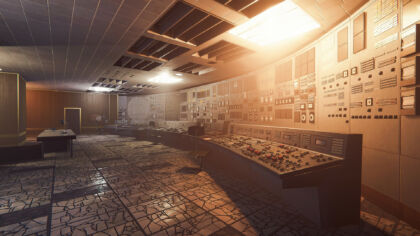
Source: Steam
Chernobyl Liquidators Simulator is a realistic take on the disaster, where you will NOT fight mutants and monsters, instead work hard to contain the radiation, help the people and conspire with the government.
Call of Duty 4: Modern Warfare

Source: Steam
Although this game is not focused on Chernobyl, it does feature some of the surrounding locations. One of the missions will take you to the city of Pripyat, from where you can clearly see the famousChernobyl NPP.
#23 CHERNOBYL SARCOPHAGUS DISMANTLING

In November 2016, New Safe Confinement covered Shelter facility. The surveys and expert evaluations, held within the whole period of Shelter existence, have revealed the structures the probability of whose collapse is very high:
„The removal of every element will increase the risk of shelter collapse that in turn will cause the release of large amounts of radioactive materials,“ the Ukrainian company SSE Chernobyl NPP said in a statement.
So on July 29, 2019, it signed a $78 million contract with a construction company to take the sarcophagus apart by 2023. Now, the entire sarcophagus has to be dismantled before it comes tumbling down.
The construction workers will have to reinforce the sarcophagus while its parts are being disassembled (with the help of robotic cranes). The pieces will then be cleaned and shipped off for recycling or disposal.
Once the sarcophagus has been dismantled, workers will begin the gargantuan task of cleaning up the radioactive waste that still lingers at reactor No. 4. The process will involve vacuuming radioactive particles and clearing out the „lava“ mixture that formed when Soviet workers dumped sand, lead, and boron into the burning reactor. These efforts are expected to last through 2065.
#24 UKRAINIAN ARMY TRAININGS IN PRIPYAT
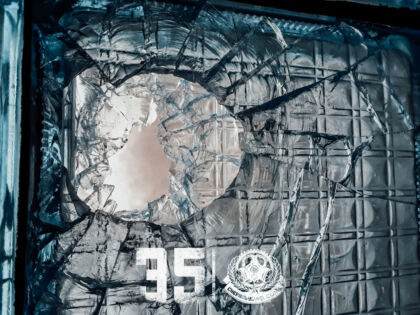
Bullet holes, the result of military training exercises, can be found throughout Pripyat
Little is known about the troop training sessions that take place near the Chernobyl NPP, the site of the world’s worst nuclear disaster in 1986. That’s true in buildings across the entire abandoned city Pripyat you can find bullet holes. They are due to military target practice, not adventurers hunting for mutants and zombies, as the tourists might think.
But the Chernobyl Exclusion Zone is not a safe military training area. The buildings are in danger of collapsing and the soldiers could be injured.
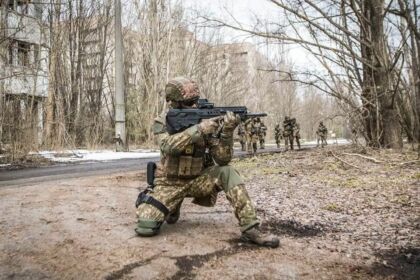
Ukrainian militaries are having trainings in Pripyat city.
The military exercises could also pose a danger to stalkers (illegally entered people) who are looking for an adventure. According to the national guard “Buildings are searched and warnings issued via loudspeakers a day before the exercise”. But it is doubtful that every home in a city that once housed 50,000 people can be inspected. It is also unclear whether the warnings are heeded.
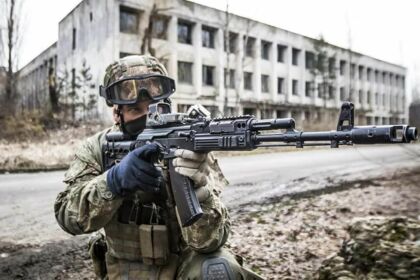
The biggest harm gets the city of Pripyat by destroying historical buildings. The national guard said there is no cause for concern, saying: „Measures are being taken in the city to prevent the destruction of buildings, and projectiles are only fired at previously prepared targets, for instance into sandbags.“ The many bullet holes in buildings show, however, that this is not always the case.
Nowadays, the Ministry of Culture, Youth and Sports continues to work on adding Pripyat and the Chernobyl Exclusion Zone on the UNESCO World Heritage list.
#25 CHERNOBYL DOGS
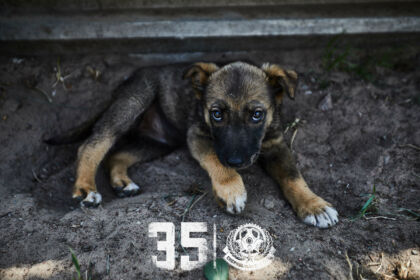
Hundreds of dogs inhabit the Chernobyl Exclusion Zone that covers a 30-kilometer radius around Chernobyl in northern Ukraine. They are the descendants of the pets left behind in 1986. When residents of Pripyat fled the explosion at the Chernobyl NPP they were forced to abandon their pets.
During the process of eliminating the consequences of the Chernobyl disaster, soviet soldiers tried to kill as many of the animals as possible to stop them from spreading radiation, but they couldn’t get to all of them.

Thankfully many survived, despite high levels of radiation in their fur, the harsh Ukrainian winters and scarcity of food. 35 years later, the offspring of these brave animals still live in the Exclusion Zone and receive veterinary care from the Dogs of Chernobyl programme.
The Dogs of Chernobyl programme has treated more than 1500 animals in the last three years. It operates shelters and clinics in Pripyat and spays, neuters, and vaccinates dogs to keep the population at a manageable size. The programme is operated by Clean Futures Fund, a US non-profit.
According to Clean Future Fund “Over 250 stray dogs live around the Chernobyl nuclear power plant, over 225 stray dogs live in Chernobyl City, and hundreds of other dogs live at the various security checkpoints and roam throughout the Exclusion Zone”.
CFF needs your help to purchase vaccines, anesthesia and medical supplies necessary to spay and neuter over 500 animals. If you have the chance to help you can donate now, and spread the word to help!
#26 CHERNOBYL VEHICLE GRAVEYARDS

35 years after the Chernobyl accident , many of the contaminated vehicles used in the clean-up operation remain in graveyards in the vast Exclusion Zone around the reactor. Here are the most popular:
„Buryakovka“ Graveyard
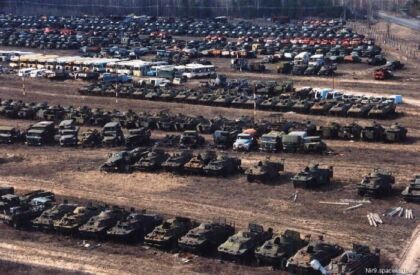
„Buryakovka“ RWDF (radioactive waste disposal site) – is a large fenced field. There are about 30 trenches with buried radioactive materials. There is also a site with „dirty“ equipment involved in the elimination of the consequences of the Chernobyl accident. To visit this burial point is quite difficult.
„Rossokha“ Graveyard

There used to be one more cemetery – „Rossokha“, located in the area of the village of the same name. It was extremely interesting for stalkers. There were a huge number of buses, motorcycles, armored vehicles, trucks and other special equipment, as well as helicopters that took part in eliminating the consequences of the disaster. In general, Rossokha housed equipment with a total cost of $ 48 million.
In 2006, the process of liquidating the „Rossokha“ graveyard was started. The equipment was deactivated, sawn and taken out for remelting and disposal. At the end of 2012, Rossokha was officially liquidated. At the moment, the equipment on the territory of the cemetery in „Rossokha“ has been preserved only in the form of a few remaining scrap metal.
The Mobile Mechanized Autocade №35 (russsian ATX 2)

It was a vehicle repair facility and a garage on the outskirts of Pripyat. It had been in use and guarded until 2019. The ATX 2 site remains an extremely interesting place to visit and since 2020 it’s possible to see. There are a lot of trucks, but the most notable exhibits are two mid-engined, 8-wheel drive MAZ-537 military trucks (with the engine compartment removed) and the IMR engineer vehicle.
#27 RADIOACTIVE CLAW

The Claw sits alone in a dead pocket of a forest on the outskirts of Pripyat, where it was abandoned in the aftermath of the clean-up efforts following the 1986 disaster.
The Claw is a large piece of crane machinery that was used in the weeks after the Chernobyl disaster of April 26, 1986 to help clean up the radioactive graphite and material that exploded out of reactor four and onto the neighbouring roofs of the power plant.

The Claw at the Chernobyl Nuclear Power Plant, 1986.
When it was no longer useful, the Claw was removed from the crane and dumped deep in a forest where it was hoped nobody would find it. Today, it’s become a creepy relic of the tragedy that happened 35 years ago.
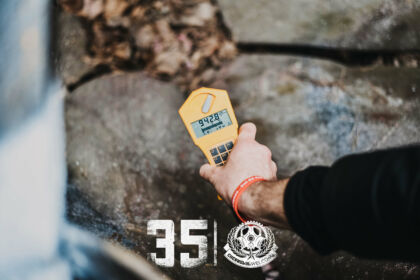
Gamma + beta readings inside of it reach over 900 microsieverts per hour.
Sadly the Claw has been vandalised twice. In November 2019 a group of vandals spray painted the Claw pink. It was quickly restored to its original yellow-golden colour and few stalkers painted it again. Shortly after the same vandals painted white stripes on the Claw.

As for the Claw, many people believe that it will stay in the forest forever because nobody wants to move it.
#28 THE ONLY CHILD BORN AND RAISED INSIDE THE CHERNOBYL EXCLUSION ZONE
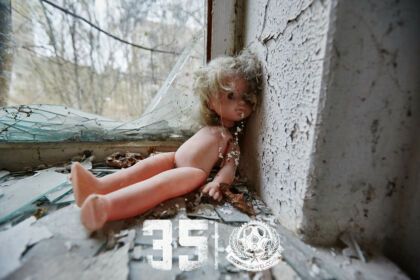
According to official rules, giving birth and raising children in the 30-kilometer Exclusion Zone of the Chernobyl Nuclear Power Plant is strictly prohibited. 13 years after the atomic disaster, in one of the more nonexistent villages was born Mariika Savenko.
Mariika’s parents refused to leave their homes and evacuate along with everyone. Lydia Savenko was already 47 years old when she realized that she was pregnant. Doctors did not agree with this fact and argued that Lydia had advanced cancer. Their surprise knew no bounds when a woman after 9 months gave birth to a completely healthy baby girl.

Mariika drank milk from cows living on the same contaminated site.
Photo: east2west news
Problems for Mariika and her family began immediately after the birth. The law prohibits giving birth to children in the Exclusion Zone and this case was the only one during its existence. Local authorities did everything possible to hide the birth of the child. The Savenko family was asked to leave, disappear, dissolve, but it was all in vain – the girl’s parents were not going to leave their home.

Mariyka pictured inside her Chernobyl home.
Photo: east2west news
Savenko left their homes only when the girl was seven years old. There are officially no children in the 30-kilometer zone, which means there are no schools either, so we had to move closer to the benefits of civilization in order to ensure the future of the child.
Now Mariika Savenko is 22 years old and she lives and studies in Kyiv. She has no health problems. The girl does not associate herself with the Exclusion Zone and does not believe that she is unique.
“People believe that Mariika is a symbol of the revival of Chernobyl, a sign of God, which they interpret as a blessing to live here, and that life is returning to this ruined place,” notes Mariika’s mother.
#29 DESTROYED SUMMER CAMP “EMERALD”

The ‘Emerald’ summer camp was a holiday resort of some 100 cabins set in a pine grove near Chernobyl. Featuring a cinema, shop, library, ballroom and boat station many of the cabins were also painted with children’s cartoon characters.
In the aftermath of the Chernobyl disaster some of the ‘liquidators’ tasked with decontaminating the area settled and made use of the cabins.

This place hidden only a few steps from the main road in the deep woods by the cooling pond was one of the most recognizable places in the Chernobyl Exclusion Zone. Three decades on, the deserted remains stood abandoned in the wood until April 2020.
The Emerald camp was destroyed by forest fire in April 2020, a heartbreaking loss for everyone, who is interested in Chernobyl, whether they had a chance to see this iconic place or missed it.
#30 INSIDE CHERNOBYL’S NEW SAFE CONFINEMENT

It has been 5 years since a giant steel shelter was slid into position over Chernobyl’s crumbling radioactive ruins. The New Safe Confinement (NSC) was deployed in November 2016 to contain radiation from the NPP for 100 years.

Upon entering the NSC, the old, worn Sarcophagus comes into view. It had not been built with the intention of being a permanent construction. Working under the pressure of time and in extremely difficult and dangerous conditions, the workers had to build it quickly in order to cover the damaged reactor and halt the emission of radioactive materials into the atmosphere.
It was accomplished in 200 days, but the haste caused the stability and tightness of the sarcophagus to be less than ideal. It is estimated that, after more than 30 years, the total area of cracks in the roof and walls is about 1000 square meters. In 2008 construction was carried out to strengthen the unstable fragments, reducing the risk of the entire structure collapsing and extending its maximum end-of-service-life deadline to 2023.
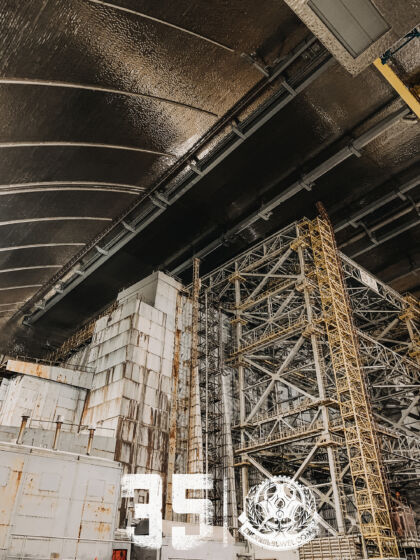
Approaching the walls of the old Sarcophagus, the radiation levels increase and the dosimeter beeps with increasingly intense warnings. Measuring radiation inside you can see from 100 to 200 µSv/h, nearly 1000 times higher than normal radiation levels. Of course, the closer you get to the sarcophagus, the higher the radiation.
#31 SELF-SETTLERS
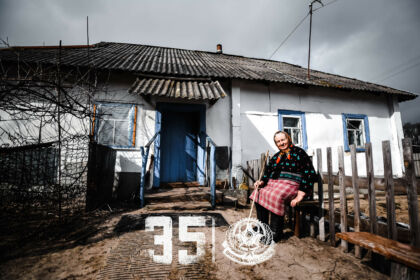
You don’t hear much about people willing to return to Fukushima, only accounts of the many who refuse to go back to areas now declared safe. With memories of Hiroshima and Nagasaki, they have their reasons to be leery.
For the people of Chernobyl, the horrors of World War II were worse than by the nuclear disaster. Why? They knew who they were fighting. By Chernobyl accident they didn’t see, feel or know what is radiation. Many Chernobyl residents just didn’t believe in this “invisible enemy” and thought that the government wanted to steal their home.
Who are “Self-settlers”?
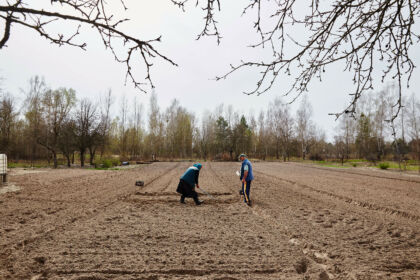
These are residents of the 30-kilometer Zone of Alienation surrounding the most heavily contaminated areas near the Chernobyl NPP in Belarus and Ukraine.
The first wave of return began weeks after the evacuation and lasted about two years. Two main reasons for returning – disorder in a new place and homesickness. The majority of the samosely are elderly people, almost all of them are women, who made their home in the area prior to the 1986 Chernobyl disaster, although some are disaffected settlers from outside the region.
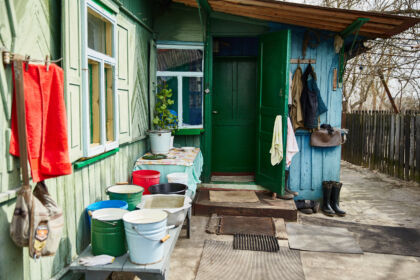
Self-settlers became an integral part of the reality of the Exclusion Zone. In 1987-1990 they lived in Chernobyl and 17 villages. Unfortunately, the population of the Zone is decreasing. As for example, in 1987 there were 1200 of self-settlers, today there lives about 110 people. Why? People die, but not because of the radiation or influence by the consequences after the accident at ChNPP. People die because of their age. The average age of the self-settlers is 75-80 years old.
#32 IGNALINA TWIN SISTER OF THE CHERNOBYL NPP
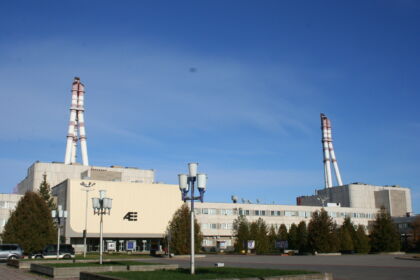
The Ignalina Nuclear Power Plant is located in eastern Lithuania near Visaginas – a town of more than 20,000 people founded in the mid-1970s for workers constructing INPP and for the purpose of supporting the plant (the same as Pripyat). INPP operated two RBMK-1500 water-cooled graphite-moderated channel-type power reactors – the same reactor type as was installed at the Chernobyl NPP, although that plant had four 1,000-MW reactors.
During its most productive year, the dual-unit facility located in eastern Lithuania supplied more than 88% of the country’s total electricity demand
Following the Chernobyl accident in 1986, plans for additional units at INPP were scrapped, even though Unit 3 was estimated to be about 60% complete. The two finished units were allowed to operate, albeit at a reduced thermal power output (roughly 87.5% of the original design capacity).
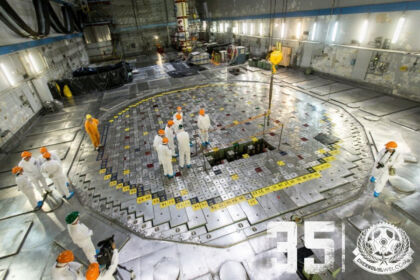
During the process of preparing for accession to the EU and NATO, and at the urging of the international community, the Lithuanian government agreed to retire INPP. Unit 1 was permanently shut down in December 2004 and Unit 2 was removed from service in December 2009. As part of the agreement, the EU is funding a portion of INPP’s decommissioning costs.
Dismantling work started on Unit 1 in 2010. INPP says that since 2010, it has dismantled 24,700 tons of the 131,000 tons of equipment estimated to be on site. Units 1 and 2 spent fuel storage pools defueling will be completed in 2022,
R1, R2 zones dismantling in 2027. In 2034 will be dismantled and decontaminated of units 1 and 2 reactors R3 zones. Unrestricted release of reactor areas – 2036.
Site restoration will be completed in 2038.
#33 PINK FLOYD IN CHERNOBYL
7 years ago, the video for Marooned was released, marking the 20th anniversary of Pink Floyd’s The Division Bell.
Part of the video clip for the song Marooned by the British rock group Pink Floyd was filmed in the Ukrainian city of Pripyat, whose residents were completely evacuated after the accident at the Chernobyl Nuclear Power Plant in 1986. The video clip was published on the website dedicated to the reissue of Pink Floyd’s last, 14th disc, The Division Bell, which was recorded in 1994.
The first part of the video shows footage from NASA, the second – landscapes of abandoned Pripyat interspersed with archival footage made by Soviet operators before the Chernobyl accident. At the same time, a man appears in the frame all the time, hiding in abandoned buildings. Filming took about two weeks.
#34 CHERNOBYL ELEPHANT’S FOOT

Artur Korneyev, Deputy Director of Shelter Object, viewing the “elephants foot” lava flow at Chernobyl, 1996
The Elephant’s Foot is the nickname given to a large mass of corium and other materials formed underneath the Chernobyl Nuclear Power Plant, during the Chernobyl disaster of April 1986. Discovered in December that year, it is presently located in a steam distribution corridor underneath the remains of Reactor No. 4. It remains an extremely radioactive object; however, its danger has decreased over time due to the decay of its radioactive components.
At the time of its discovery, about eight months after formation, radioactivity near the Elephant’s Foot was approximately 8,000 roentgens, or 80 grays per hour, delivering a 50/50 lethal dose of radiation (4.5 grays) within five minutes.
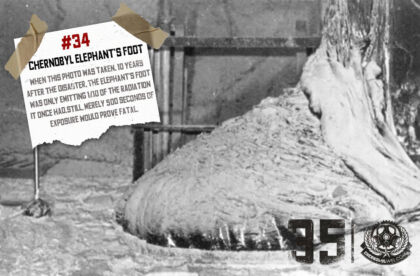
Since that time the radiation intensity has declined enough that, in 1996, the Elephant’s Foot was visited by the Deputy Director of the New Confinement Project, Artur Korneyev, who took photographs using an automatic camera and a flashlight to illuminate the otherwise dark room.
The Elephant’s Foot had flowed through at least 2 m of pipes and fissures to reach its current location. There were fears that the corium might continue to penetrate deeper into the ground and come into contact with groundwater, contaminating the area’s drinking water and leading to illnesses and deaths; however, as of 2016, the mass has not moved significantly since its discovery and is estimated to be only slightly warmer than its environment due to heat from the ongoing nuclear decay.
Born of human error, continually generating copious heat, the Elephant’s Foot is still melting into the base of the Chernobyl NPP.
Long after bleeding from the core, this unique piece of waste continues to be a testament to the potential dangers of nuclear power. The Elephant’s Foot will be there for centuries, sitting in the dark basement of a concrete and steel sarcophagus, a symbol of one of humankind’s most powerful tools gone awry.
#35 YEARS AFTER – FUTURE OF CHERNOBYL

It has been 35 years since that terrible night, April 26, 1986, when the „peaceful atom“ escaped from the 4th reactor of the Chernobyl Nuclear Power Plant.
Every year, we discuss the terrible consequences of the Chernobyl catastrophe, horrible mistakes, but this year we wanted to talk about Chernobyl Today. This year we wanted to show you Chernobyl nowadays without prejudices, stereotypes, and lies. The last fact this year, but the most important – future. Let’s talk about Future of Chernobyl.
According Ukrainian authorities there are such following areas of the Exclusion Zone development:
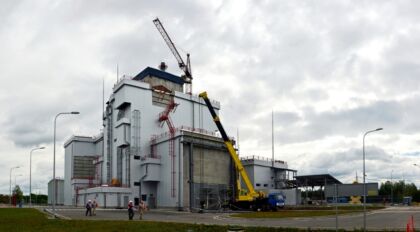
New Interim Spent Nuclear Fuel Dry Storage Facility (ISF-2) near Chernobyl NPP
Source: chnpp.gov.ua
- Barrier function and safe management of spent nuclear fuel and radioactive waste.The State is creating facilities in the Exclusion Zone – centralized long-term storage and disposal of spent nuclear fuel and radioactive waste. For example near the Chernobyl NPP situates a new Interim Spent Nuclear Fuel Dry Storage Facility (ISF-2), which was built in cooperation with American company Holteс International. On December 14, 2020, the hot testing active phase was completed, during which186 spent fuel assemblies were moved to ISF-2

- Revival of the territory as a cultural heritage and tourist magnet.Exclusion Zone is a place where people can see the scale of human activity and its impact on the planet. This year we made the first big step – Chernobyl Duga Radar was included in the state register of monuments of Ukraine.
The push from the Ukrainian government to designate Chernobyl as a World Heritage Site has actually been on the back-burner for several years now. Following the completion of New Safe Confinement over the 4th reactor in 2016. Officials are now at work readying certain elements of the Exclusion Zone to propose to the United Nations for designation. A final decision from UNESCO would likely arrive by 2023 at the latest.
- A separate industrial cluster.This is promoted by attracting significant investment in the territory development. Today we already have a project SOLAR CHERNOBYL where the alternative energy is being generated. It’s a collaboration between Ukrainian company Rodina and Germany’s Enerparc AG.
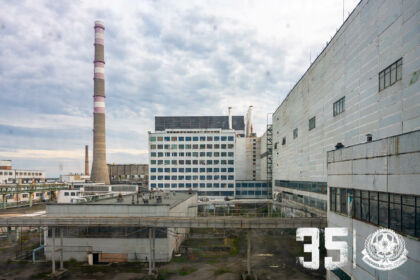
Chernobyl Nuclear Power Plant
Photo: Albert Clee
- Modern and comfortable platform for the activity of Ukrainian and foreign scientists.Nuclear physicists, environmental specialists, chemists, physicists from around the world had visited the Chernobyl Zone. After the Fukushima disaster many Japanese scientists and researchers came to Chernobyl to get to know more about the consequences of this catastrophe to avoid mistakes.
- Development of the Chernobyl Radiation and Ecological Biosphere Reserve.A unique place of preservation of natural complexes of Polissia. Only here you can see rare species living on the territory which was affected by enormous levels of radiation.
Radioactively yours ChernobylWelcome



 ChernobylX
ChernobylX
 ChernobylX
ChernobylX